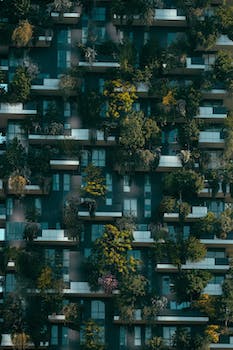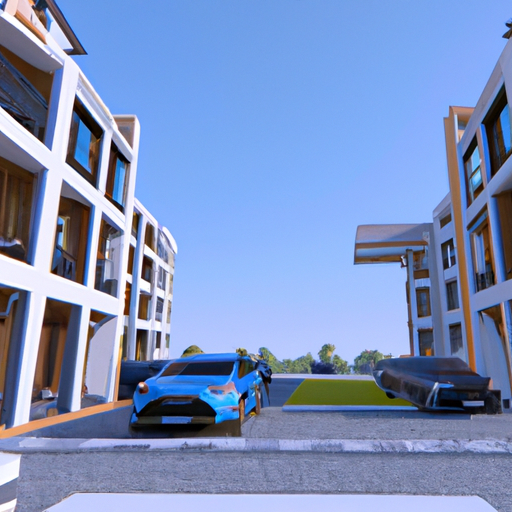Integrating Sustainability and Functionality in Small Community Complex Design
Designing a modern complex that is perfect for a small community requires a delicate balance between sustainability and functionality. The goal is to create a space that not only meets the needs of the community but also promotes environmental responsibility and long-term viability. This can be achieved through careful planning, innovative design, and a commitment to incorporating sustainable practices throughout the entire process.
One of the first steps in designing a modern complex for a small community is to assess the needs and desires of the community itself. This can be done through surveys, focus groups, and community meetings, allowing residents to voice their opinions and preferences. By understanding the unique characteristics and requirements of the community, designers can create a complex that is tailored to meet these needs while also promoting a sense of belonging and pride among residents.
Once the needs of the community have been identified, designers can begin to incorporate sustainable practices into the design of the complex. This can include the use of energy-efficient materials and technologies, such as solar panels, green roofs, and rainwater harvesting systems. These features not only help to reduce the environmental impact of the complex but can also lead to cost savings for residents and the community as a whole.
In addition to incorporating sustainable technologies, designers should also consider the layout and orientation of the complex. By strategically positioning buildings and outdoor spaces to take advantage of natural light and ventilation, designers can create a complex that is not only energy-efficient but also comfortable and inviting for residents. This can be particularly important in small communities, where residents may spend a significant amount of time within the complex and its surrounding spaces.
Another key aspect of designing a modern complex for a small community is to create spaces that promote social interaction and a sense of community. This can be achieved through the inclusion of communal spaces, such as parks, gardens, and courtyards, as well as shared amenities, such as community centers and recreational facilities. By providing opportunities for residents to interact and engage with one another, designers can help to foster a strong sense of community and belonging within the complex.
In addition to communal spaces, designers should also consider the needs of individual residents when designing a modern complex for a small community. This can include providing a mix of housing types and sizes to accommodate a diverse range of residents, as well as ensuring that homes are designed with accessibility and adaptability in mind. By creating a complex that caters to the needs of all residents, designers can help to promote inclusivity and ensure that the complex remains a vibrant and thriving community for years to come.
Finally, designers should consider the long-term viability of the complex when designing a modern complex for a small community. This can include incorporating sustainable materials and practices that are not only environmentally responsible but also durable and low-maintenance. By designing a complex that is built to last, designers can help to ensure that the community continues to benefit from the complex and its amenities for generations to come.
In conclusion, designing a modern complex that is perfect for a small community requires a careful balance between sustainability and functionality. By understanding the unique needs of the community, incorporating sustainable practices and technologies, and creating spaces that promote social interaction and inclusivity, designers can create a complex that is not only environmentally responsible but also a vibrant and thriving community hub. With careful planning and a commitment to sustainability, designers can create a modern complex that is truly perfect for a small community.
Creating Cohesive Community Spaces: Designing Modern Complexes for Small Neighborhoods

Designing a modern complex that is perfect for a small community requires a thoughtful approach that takes into consideration the unique needs and preferences of the residents. The goal is to create a space that fosters a sense of belonging, encourages social interaction, and promotes a healthy and sustainable lifestyle. In this article, we will explore some key principles and strategies that can help architects and urban planners achieve this objective.
First and foremost, it is essential to understand the demographics and cultural background of the community for which the complex is being designed. This information can be gathered through surveys, interviews, and focus groups, as well as by studying the history and traditions of the area. By gaining a deep understanding of the community’s values, preferences, and aspirations, designers can create a complex that truly reflects the identity of its residents and fosters a sense of pride and ownership.
One of the most important aspects of designing a modern complex for a small community is to create a variety of spaces that cater to different needs and activities. This can include a mix of residential, commercial, and recreational spaces, as well as green areas and public squares. By offering a diverse range of amenities and services within the complex, residents can enjoy a convenient and fulfilling lifestyle without having to travel far from their homes.
In addition to providing a variety of spaces, it is crucial to ensure that these spaces are well-connected and easily accessible. This can be achieved by designing a network of pedestrian-friendly streets and pathways that encourage walking and cycling, as well as by providing ample public transportation options. By prioritizing connectivity and accessibility, designers can promote social interaction and create a sense of community among residents.
Another key principle in designing a modern complex for a small community is to prioritize sustainability and environmental responsibility. This can be achieved by incorporating energy-efficient building materials and technologies, as well as by promoting the use of renewable energy sources such as solar panels and wind turbines. Additionally, designers can incorporate green spaces and natural elements into the complex, such as parks, gardens, and water features, which not only enhance the aesthetic appeal of the complex but also contribute to the overall well-being of the residents.
In order to create a cohesive community space, it is important to pay attention to the architectural style and design elements of the complex. By adopting a consistent design language and using materials and colors that complement the surrounding environment, designers can create a visually harmonious and unified complex that is both aesthetically pleasing and functional.
Furthermore, it is essential to involve the community in the design process, as this can help ensure that the complex meets the needs and expectations of its residents. By organizing workshops, consultations, and participatory design sessions, architects and urban planners can gather valuable feedback and insights from the community, which can then be incorporated into the final design.
Finally, it is important to consider the long-term maintenance and management of the complex, as this can have a significant impact on the overall success and sustainability of the project. By establishing a strong governance structure and involving the community in the decision-making process, designers can ensure that the complex remains well-maintained and continues to serve the needs of its residents for years to come.
In conclusion, designing a modern complex that is perfect for a small community requires a comprehensive and thoughtful approach that takes into account the unique needs and preferences of the residents. By creating a diverse range of well-connected and accessible spaces, prioritizing sustainability and environmental responsibility, and involving the community in the design process, architects and urban planners can create a cohesive and vibrant community space that fosters a sense of belonging and promotes a healthy and sustainable lifestyle.
Balancing Aesthetics and Practicality: Key Elements for Designing a Modern Small Community Complex
Designing a modern complex that caters to the needs of a small community requires a delicate balance between aesthetics and practicality. The complex should not only be visually appealing but also functional, providing residents with a comfortable and convenient living environment. This article will discuss the key elements that architects and designers should consider when creating a modern small community complex that strikes the perfect balance between form and function.
One of the most important aspects of designing a modern complex for a small community is ensuring that it blends seamlessly with its surroundings. This means taking into consideration the local architectural styles, materials, and colors, as well as the natural landscape. By incorporating elements of the local environment into the design, architects can create a complex that feels like an organic extension of the community, rather than an imposing, out-of-place structure.
Another crucial element in designing a modern small community complex is creating a sense of cohesion and unity among the various buildings and spaces within the complex. This can be achieved through the use of consistent architectural styles, materials, and colors, as well as by incorporating shared amenities and communal spaces that encourage interaction among residents. These shared spaces can include parks, gardens, courtyards, and recreational facilities, which not only foster a sense of community but also provide opportunities for residents to enjoy the outdoors and engage in physical activity.
In addition to creating a cohesive and unified aesthetic, it is essential for architects and designers to prioritize functionality and practicality when designing a modern small community complex. This means ensuring that the complex is easily accessible and navigable, with clear signage and well-lit pathways that guide residents and visitors through the space. It also means providing ample parking and storage solutions, as well as designing buildings and spaces that are energy-efficient and environmentally friendly.
One way to achieve this is by incorporating sustainable design principles, such as passive solar design, green roofs, and rainwater harvesting systems. These features not only help to reduce the complex’s environmental impact but can also contribute to a more comfortable and pleasant living environment for residents. For example, passive solar design can help to regulate indoor temperatures, reducing the need for artificial heating and cooling, while green roofs can provide insulation and help to mitigate the urban heat island effect.
Another key element in designing a modern small community complex is ensuring that it caters to the diverse needs and preferences of its residents. This means providing a mix of housing types and sizes, as well as a range of amenities and services that cater to different age groups, lifestyles, and interests. For example, a complex might include a mix of single-family homes, townhouses, and apartments, as well as shared facilities such as a gym, swimming pool, and community center.
In conclusion, designing a modern complex that is perfect for a small community requires a careful balance between aesthetics and practicality. By incorporating elements of the local environment, creating a cohesive and unified aesthetic, prioritizing functionality and sustainability, and catering to the diverse needs of residents, architects and designers can create a complex that not only looks great but also provides a comfortable, convenient, and enjoyable living environment for its residents. By considering these key elements, designers can create a modern small community complex that truly enhances the quality of life for those who call it home.
Q&A
Question 1: What are the key elements to consider when designing a modern complex for a small community?
Answer 1: The key elements to consider when designing a modern complex for a small community include: efficient land use, mixed-use spaces, accessibility, sustainability, community engagement, and aesthetic appeal.
Question 2: How can a modern complex promote social interaction and a sense of community among its residents?
Answer 2: A modern complex can promote social interaction and a sense of community by incorporating shared spaces such as community gardens, parks, playgrounds, and multi-purpose halls, as well as designing walkable paths and encouraging mixed-use spaces where residents can live, work, and socialize.
Question 3: What sustainable features can be incorporated into the design of a modern complex for a small community?
Answer 3: Sustainable features that can be incorporated into the design of a modern complex include energy-efficient building materials, solar panels, green roofs, rainwater harvesting systems, waste management systems, and the use of native plants in landscaping to reduce water consumption.
Conclusion
In conclusion, designing a modern complex for a small community requires a thoughtful approach that prioritizes the needs and preferences of the residents. This includes incorporating sustainable and eco-friendly materials, providing a mix of housing options, creating shared spaces for social interaction, and ensuring accessibility to essential amenities and services. By focusing on these key aspects, a well-designed modern complex can foster a strong sense of community, enhance the quality of life, and promote sustainable living for its residents.


